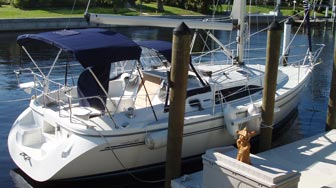
The Catalina 309
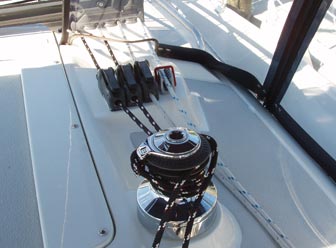
A self-tailing winch on the coachroof can be used for the outhaul or the mainsheet, but in practice is only needed for fine adjustments in strong winds.
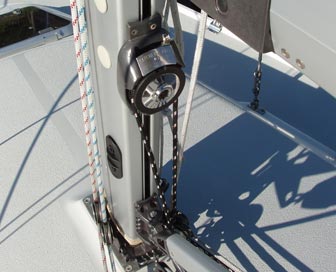
The furler loop turns a winch that is mounted into the mast. The winch actually turns the furler itself. In an emergency, you can crank in your sail by using a winch handle.
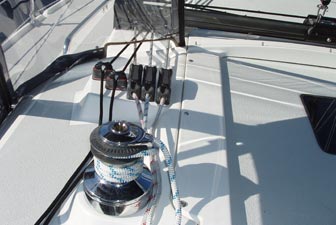
The jib and spinnaker halyards and the line for the rigid boom vang are all led through stoppers to a self tailing winch.
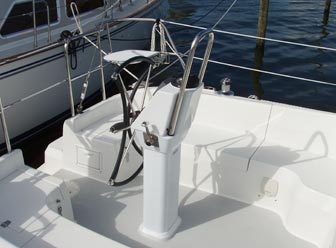
The folding steering wheel makes even more room in the already-roomy cockpit
Sailing the Catalina 309: A Review
The Catalina 309 sails like a dream. Serious sailors may think that the standard in-mast furling mainsail doesn't look like serious sailing equipment, but to them I say, "just try it." That mainsail may look funny, and there is not a telltale anywhere on it, but it drives the boat nicely, and is the easiest sail to operate you have ever seen on a boat this size. You can adjust the size and shape of the sail to suit conditions, and the boat responds quickly to those adjustments, letting you know what works and what does not.
Catalina Yachts designer Gerry Douglas has hit a home run with the Catalina 309 in many ways, but my favorite part of the boat is the in-mast furling mainsail and its controls. The furler can be operated by a continuous loop of line which is run underneath the traveler and through a pair of rope clutches on the starboard side of the companionway. Next to those are the outhaul, also led through a line clutch, and the mainsheet, led through a heavy duty jam cleat. A self-tailing winch on the coachroof can be used for the outhaul or the mainsheet, but in practice is only needed for fine adjustments in strong winds.
The furler loop turns a winch that is mounted into the mast, and the winch actually turns the furler itself. In an emergency, you can put a handle in that winch and crank in your sail. The furling line cannot become entangled inside the mast, because it never enters the mast at all.
The 309 is Light and Maneuverable, With Quick Helm Response
The boat is light and maneuverable enough, and the sails are not all that heavy, so a quick pinch into the wind will allow you to pull the outhaul to flatten the sail or trim in the main and jib sheets without using the winch in winds up to 15 knots or so. Helm response is quick, so if you're quick on the lines, you won't lose much speed at all.
Easy Sail-Handling and Reefing
Reefing is quick and easy. Just release the outhaul and pull one side of the furling loop with the other released, and the sail rolls away inside the mast. You can then close the furler and outhaul clutches, pull the outhaul tight, and you have a smaller mainsail. You are not limited to one, two, or three reef points. If the conditions dictate that you fly 1/2 of your mainsail and 1/2 of your roller furling jib, you can do that. We did, and we sustained an average of almost 7 knots for a few hours.
It was easy to set the sails so that the boat's helm was balanced and we were not heeling too much as we cruised up Charlotte Harbor. In the gusts of wind in the mid to high 20s, we were of course overtrimmed, but compensation was easy with the traveler. Both traveler lines are led to cam cleats on the port coachroof. We were on a port tack the entire time, and I was able to sit behind the traveler controls and ease the main out during the gusts, then quickly pull it back up as the gust subsided. If I got distracted by a bag of chips or something of similarly pressing importance when a gust came along, the helm was overpowered and the boat would round up, but as long as I played those traveler lines with the wind, our helm was balanced and we had great speed through the gusts.
Also on that side are the jib and spinnaker halyards and the line for the rigid boom vang, all led through stoppers to a self tailing winch.
I would like to see the vang and traveler lines led to the other side with all the other mainsail controls, but that would require an asymmetric cockpit with the companionway offset to the other side. It would allow a nice, long bench along the bulkhead, and someone resting on it could control every aspect of mainsail size and shape without getting up. The mass market may not be ready for my wacky idea.
The Mainsail Halyard
Where, you might ask, is the mainsail halyard? It is led through a clutch on the mast, and can be coiled out there, out of the way. If you must tension it, it can be led through a block at the mast step and to a cockpit winch, but that is usually unnecessary once the sail and halyard are broken in.
Catalina 309 is Roomy Even for a Six-Footer
The cockpit of the 309 is vast. I'm 6 feet tall, and when I sit on one side of the cockpit, my feet are nowhere near the bench on the other side. We put a 48 quart cooler in the cockpit, and it is the perfect size to fill that gap and give you somewhere to brace your feet when the boat is heeling. The stern rail seats are comfortable. They have a great view and a drink holder, as all stern rail seats should. The coaming is set at a comfortable angle to sit on under sail, and is low enough to make exiting the cockpit underneath the Bimini top easy. The side decks are wide, with excellent non-skid, and the inboard chainplates make going forward safe and simple. The cockpit lazarette locker is cavernous. It is deep enough that it is kind of awkward even for a tall person to get inside, but there is a huge amount of storage space in there. The trash can is in there, with a flap in the bulkhead so that it can be used from the galley. When it is full, you don't have to carry a stinky trash bag through the cabin, as it is already outside.
Engine access on the 309 is outstanding, with complete access to three sides of the Yanmar fresh water cooled diesel engine once the companionway step is swung out of the way or removed. It also provides great access to the transmission and dripless shaft seal under a panel in the quarterberth. All through-hull fittings are labeled and easily accessible. It is generally an easy boat to maintain or upgrade.
The galley and main salon have good headroom and ventilation. The beam of this boat makes it feel much larger than its actual 31 foot LOA. Four of us ate at the salon table, with plenty of room for a couple more. When the table is stowed away, movement around the cabin is unrestricted. A handrail overhead allows safe passage forward in a seaway, or lets you stand at the navigation station if you don't wish to sit down.
The V-berth is comfortable, and I like how the filler panel slides away forward when not in use. My wife and I slept up there and had adequate space even though she is a notorious berth-hog. Or maybe I am. (Wife's note: he is.) Anyway, it worked out fine on the Catalina 309.
Dinghy Access, Electronics
We were towing a West Marine inflatable dinghy, and getting on and off through the walk-through transom from the swim step was easy. No one took a hot shower on the swim step in the crowded anchorage at Pelican Bay, but the shower does a great job of washing off your feet if you return with sand on them. The 4'4" draft wing keel allowed us to make our way in to the protection of the inner anchorage, while most sailboats stayed out in more wind and chop. The ability to get in to calm water also makes getting on and off a dinghy easier. A Garhauer stainless davit mounted on the stern rail with a foot mounted on the step outside the cockpit made lifting the dinghy engine on and off a breeze.
The boat we were on had a Garmin chartplotter and the factory-optional Raymarine ST 60 speed, depth, and wind instruments and the autopilot. All instruments are mounted in a NavPod on the helm pedestal, which also has all engine controls and instruments and the compass. All the instruments and controls are readily visible to and accessible by the helmsman; guests cannot sit in the way of your instruments, and you don't have to strain to see or operate anything.
Catalina 309 Conclusion
The Catalina 309 has the speed, balance, and agility to please a sailor, the ease of handling and maintenance to please an experienced boat owner, and the amenities to please your guests. It's big enough to cruise, yet small and easy enough to daysail. I expect to see lots of these boats around in the years to come, as it fills all the needs most sailors want.
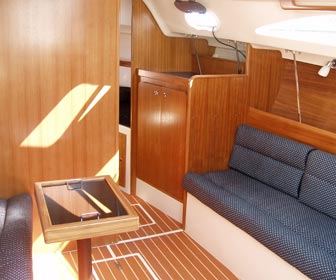
The Catalina 309's salon is roomy and spacious, with enough headroom for a 6-footer to stand up straight just about everywhere
Leave a Reply
You must be logged in to post a comment.